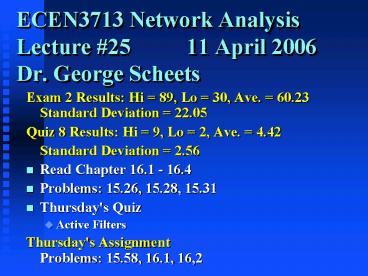ECEN3713 Network Analysis Lecture
1 / 16
Title: ECEN3713 Network Analysis Lecture
1
ECEN3713 Network AnalysisLecture 25 11
April 2006Dr. George Scheets
- Exam 2 Results Hi 89, Lo 30, Ave.
60.23Standard Deviation 22.05 - Quiz 8 Results Hi 9, Lo 2, Ave. 4.42
- Standard Deviation 2.56
- Read Chapter 16.1 - 16.4
- Problems 15.26, 15.28, 15.31
- Thursday's Quiz
- Active Filters
- Thursday's AssignmentProblems 15.58, 16.1, 16,2
2
ECEN3713 Network AnalysisLecture 27 18
April 2006Dr. George Scheets
- Read Chapter 16.5 - 16.9
- Problems 16.11, 16.13, 16.16
- Thursday's Quiz
- Chapter 16
- Final Exam, Thursday, 4 May, 1400-1550
- Comprehensive, Open Book Notes
- Thursday's AssignmentProblems 16.23, 16.24,
16.29, 16.33
3
ECEN3713 Network AnalysisLecture 29 25
April 2006Dr. George Scheets
- Quiz 10 Results Hi 10, Lo 3, Ave. 5.65
- Standard Deviation 2.47
- Problems 16.34, 16.35, 16.41, 16.47
- Final Exam
- 200-350pm, Thursday, 4 May
- Office Hours
- Wednesday Office Hours 1400 - 1700 Thursday
Office Hours 0930-1130, 1230-11400
4
ECEN3713 Network AnalysisLecture 30 27
April 2006Dr. George Scheets
- Final Exam
- 200-350pm, Thursday, 4 May
- Office Hours
- Wednesday Office Hours 1400 - 1700 Thursday
Office Hours 0930-1130, 1230-11400
5
How do S-Domain poles zeroes affect frequency
domain plots?
- Real Pole
- Causes H(s) to "blow up"
- Causes H(j?) to break down
- Real Zero
- Causes H(s) to be 0
- Causes H(j?) to break up
- Complex Conjugate Pole Pairs
- Cause H(s) to "blow up" in two symmetrical
places - Cause H(j?) to have bulges
6
Single Real Pole, Two Real Poles 1/(s3),
1/(s3)2
H(?)
7
Single Real Pole, Two Real Poles 1/(s3),
3/(s3)2
H(?)
Note 2nd order system has sharper
roll-off. Also, 3 dB break point has moved.
8
Complex Conjugate Poles, real 01/(s2 100)
1/(s j10)(s j10)
H(?)
9
Complex Conjugate Poles, real gt 01/(s2 4s
104) 1/(s 2 j10)(s 2 j10)
H(?)
10
Complex Conjugate Poles, real gt 01/(s2 10s
125) 1/(s 5 j10)(s 5 j10)
H(?)
11
Correlation
x(t) y(t) dt
- Tells how "alike" x(t) and y(t) are
- If evaluates positive
- if x(t1) is positive, y(t1) tends to be positive
t1 an arbitrary time - x(t) and y(t) are similar, i.e. there is a lot
of y(t) in x(t)
12
Correlation
x(t) y(t) dt
- If evaluates negative
- if x(t1) is positive, y(t1) tends to be negative
vice-versa - x(t) and y(t) are similar but opposites
- If evaluates 0
- x(t) y(t) are not related (uncorrelated)no
predictability
13
Laplace Transform
8
F(s) f(t) e-st dt
0-
- F(3) tells how alike f(t) and e-3t are
- Over the time interval 0- to infinity
14
Fourier Transform
8
F(?) f(t) e-j?t dt
- 8
- F(3) tells how alike f(t) and e-j3t are
- Over the time interval -8 to 8
15
Fourier Series
T
an 2/T f(t) cos(n?ot) dt
0
- a3 tells how alike f(t) and cos(3?ot) are
- Over one period, T
- 1/T average
- 2 scaling factor to get power correct
16
(No Transcript)































